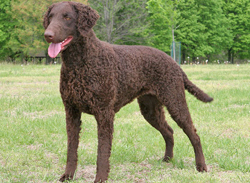Curly-Coated Retrievers are strong, robust, medium-sized dogs. Their coat consists of small, tight curls that are water-resistant, and it comes in liver or black. Their curls are their distinguishing characteristic, and they lie close to the skin and are very crisp. Curly-Coated Retrievers have large, almond-shaped eyes and small ears. They measure 23 to 27 inches tall at the shoulder and weigh 60 to 70 pounds. With proper care, these dogs live up to 15 years.
Curly-Coated Retrievers were born to run and hunt and play outdoors, and they need a good balance of love, attention, and outdoor tasks to keep them fully satisfied both mentally and physically.
This breed is intelligent, energetic, and has a great sense of humor. Curly-Coated Retrievers make loving and entertaining companion animals with sufficient training. They are ideally suited to an active household with children, and they love spending time with their human family.
The Curly-Coated Retriever dates back to the 18th century and is accepted as the oldest of the retrieving breeds.
Curly-Coated Retrievers are intelligent, charming, gentle, and affectionate dogs, and they are great with children. They are ideally suited to a household with loving, outdoor-oriented, and active family members. Although these dogs are naturally active, athletic, and determined, they are surprisingly relaxed around the home. They are easy-going and loving with family members, although they tend to be a bit more reserved and quiet around strangers.
These dogs become very strongly attached to their human family members and enjoy doing everything and going everywhere with them. This is a good breed choice for anyone who wants a shadow dog, but it's not a great match for busy people who prefer independent dogs. Their shadowing is not something that can be trained out of the breed, as it is more about devotion and affection than separation anxiety.
Curly-Coated Retrievers were born to run and hunt and play outdoors, and they need a good balance of love, attention, and outdoor tasks to keep them fully satisfied both mentally and physically. Regular exercise along with dog sports, such as flyball and agility, will keep these dogs stimulated and satisfied. Keeping them busy ensures they remain well behaved.
Curly-Coated Retrievers are a fairly healthy breed, but they are at risk for certain health conditions that can reduce quality or length of life. Congenital hip dysplasia, certain heart problems, and numerous eye conditions, such as cataracts, entropion, ectropion, distichiasis, and progressive retinal atrophy, are all known to affect the breed.
These dogs are also at risk for a type of glycogen storage disease that causes stiffness, weakness, difficulty swallowing, and exercise intolerance. Routine veterinary care to check for symptoms of health conditions common to this breed can ensure prompt diagnosis and a better prognosis.
Regular veterinary well-checks beginning early in life, routine vaccinations, a healthy diet, and regular exercise help ensure Curly-Coated Retrievers live a long, full, and active life of up to 15 years.
A biddable and intelligent breed, Curly-Coated Retrievers are highly responsive to training and good with commands. They are eager to please and make great companion animals, provided they have proper training and socialization. However, without sufficient training and a steady supply of jobs to do, these dogs will quickly become bored and destructive. Therefore, this breed is not the best choice for first-time dog owners.
Curly-Coated Retrievers are slow to mature, which means training may take a little longer than with some other breeds. Positive reinforcement generally works very well with these dogs, and the breed responds exceptionally well to play and food rewards. Of course, it is always important to limit treats and food rewards to prevent overeating and weight-related problems.
These dogs need a lot of attention and stimulation. Without plenty of company, toys, and exercise, Curly-Coated Retrievers can become noisy or destructive. In cases where human family members must be away from home for long periods, a second dog can provide much needed company. Ideally, the dogs should be raised together to prevent personality clashes and fights.
Curly-Coated Retrievers require little care. In fact, over brushing can diminish the breed's tight curls and leave the coat frizzy. A good combing, especially before swimming, can prevent matting and tangles. Scraggly hairs can be tidied with scissors, when necessary.
During shedding season, some brushing may be necessary to keep loose hair under control. Ideally, the coat should be brushed out with an undercoat rake or slicker brush before bathing. Once the hair dries, the curls will return to the coat. The degree of shedding will determine how often brushing and bathing is necessary. Otherwise, baths are only needed every month or so, unless the Curly-Coated Retriever gets into something stinky or sticky.
The nails need trimming every few weeks to prevent snagging, and the teeth require regular brushing to prevent tooth decay and periodontal disease. It is important to check the ears weekly for excess wax accumulation and signs of infection, and to clean the outer ears with a cotton ball and canine ear cleansing solution. Report any signs of infection, such as odor, discharge, pain, or redness, to a veterinarian right away.
The origin of the Curly-Coated Retriever is unclear, but this breed is one of the oldest retriever breeds in existence. These dogs possibly descended from the St. John's Newfoundland, the English Water Spaniel, the Poodle, and the retrieving setter, taking traits from all of these.
Curly-Coated Retrievers were developed in England as upland game hunters and waterfowl retrievers, where they hunted game birds such as quail, pheasant, and grouse. They excelled at both roles and quickly became a favorite of English gamekeepers due to their courage, ability, and perseverance.
By the time of the Civil War, the breed had made its way to the United States in small numbers. They were a rare breed in America during that time, and they remain fairly rare today. However, they are beloved by all who keep them.
Curly-Coated Retrievers were officially recognized by the American Kennel Club in 1924.

